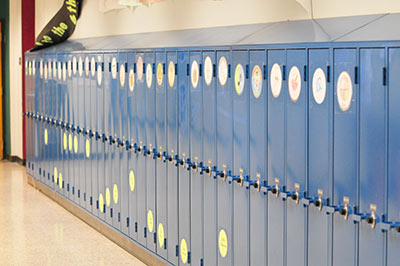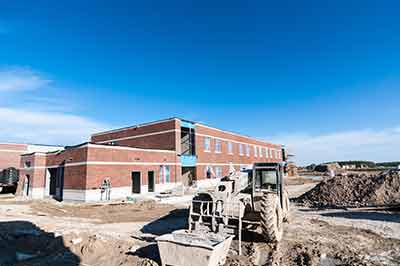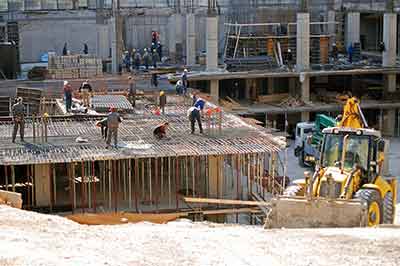The U.S. Department of Energy (2007). The U.S. Department of Energy’s Rebuild America EnergySmart Schools program provides school boards, administrators, and design staff with guidance to help make informed decisions about energy and environmental issues important to school systems and communities. The National Best Practices Manual for Building High Performance Schools is a part of the suite of products developed to promote energy efficiency and renewable energy in schools. It was developed specifically for architects and engineers who are responsible for designing or retrofitting schools, and for the project managers who work with the design teams. (Posted on August 14, 2014).
Tag: School Construction
School construction projects in Williamburg, James City on track for on-time completion
Christine Sampson (2014). JAMES CITY – School crews and contractors of the Williamsburg-James City school division have been busy this summer working on 19 different projects – all of which are on track to be completed by the time students return to school on Sept. 2, school officials reported this week. (Posted on August 4, 2014).
Which School Districts Qualified for Federal School Facility Funding under the American Recovery and Reinvestment Act of 2009? Evidence from Ohio
W. Kyle Ingle, Alex J. Bowers, and Thomas E. Davis, (2014).
The American Recovery and Reinvestment Act of 2009 (ARRA) allocated $11 billion per year for 2009 and 2010 for qualified school construction bonds (QSCBs) for America’s schools. From a historical perspective, this program is a broad transformation of the federal role in school facility funding. This study examined factors associated with federal allocations to school districts in Ohio. (Posted July 22, 2014 with permission of Journal of Education Finance).
Norfolk, Va., plans to spend $125 million on school construction
Norfolk, Va., has approved a $5 million agreement with a developer for the design of five new schools.
http://asumag.com/new-construction/norfolk-va-plans-spend-125-million-school-construction
Growth and Disparity – A Decade of U.S. Public School Construction
Building Educational Success Together (2006).
In 1995, a federal report by the General Accounting Office (GAO) estimated that $112 billion was needed to bring the nation's school facilities into good repair. Subsequent studies estimated it would take more than $320 billion to build new schools to handle swelling enrollments, renovate aging buildings, and equip all buildings with the technologies needed to prepare students for success in the 21st century. By far, though, the most troubling findings were that the academically neediest students--minorities and impoverished students--were most likely to attend the most decrepit facilities. Now, for the first time ever, this report provides a comprehensive analysis of who has benefited from school construction spending across the nation. In this report, the Building Educational Success Together (BEST) research team looks at how much was spent, what was accomplished, and which students and communities saw benefits. The analysis looks at the decade from 1995, when the GAO report was first released, to 2004, the most current information available. The authors found unprecedented spending and growth in school facility construction across the country, but this report confirms what many educators and communities have suspected for years: these billions of dollars spent on facilities have not been equally available to affluent and low-income communities and for minority and white students. Overall, the schools in poor condition 10 years ago received the least investment in their facilities, even as the nation's schools have seen record spending in school facilities. This report is a step in recognizing the tremendous opportunity and challenge of providing the highest quality education and the highest quality school buildings to all our children.
Governments Scale Back Spending on School Construction, Public Safety
Spending on school building, which is largely funded locally, declined 8.7% over the past 12 months.
Florida schools may see construction funding increase
Florida schools and colleges may see much needed construction and renovations as a result of pending legislation to provide funding for statewide public school, college and university projects. State lawmakers are advancing a $597 million Public Education Capital Outlay (PECO) budget for 2014-15 fiscal year, the Herald Tribune reported.
http://asumag.com/legislation/florida-schools-may-see-construction-funding-increase
Report – Oklahoma schools destroyed by tornado were poorly constructed
An analysis of two Oklahoma schools that were leveled by an EF5 tornado last spring has revealed significant construction errors and code violations.
Ready for Growth in Wentzville, Mo.
The Wentzville R-IV School District hosts just 283 freshmen in the newest high school this year, but it will be filled with students in the near future, as the fastest-growing district in Missouri continues to see booming enrollment. Liberty High School is the third high school in the district, which has been adding 500 students annually. The school ultimately will host up to 1,200 students.
Dodge Momentum Index Slips in February
The Dodge Momentum Index slipped 2.6% in February compared to the previous month, according to McGraw Hill Construction, a division of McGraw Hill Financial. The Momentum Index is a monthly measure of the first (or initial) report for nonresidential building projects in planning, which have been shown to lead construction spending for nonresidential buildings by a full year.
http://construction.com/about-us/press/dodge-momentum-index-slipped-in-february.asp











